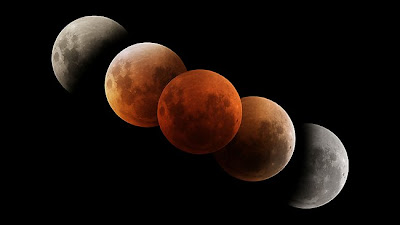LUNAR ECLIPSE

A composite image of a lunar eclipse, showing the path of the moon into and then out of earth's shadow.
A LUNAR eclipse turned the morning sky a stunning blood red colour today.
The eclipse began at 3.25am (AEST) and entered its darkest phase or "totality" at 5.22am (AEST) when the transformation to a blood-red moon began.
Sydney Observatory’s acting curator Dr Andrew Jacob said: “Deep lunar eclipses such as this typically turn a blood-red or even coppery colour, but this is very dependent on the amount of dust and cloud in Earth’s atmosphere.”
This "syzygy" - a perfect alignment of three astronomical bodies, ends at sunrise in all states but West Australia, with the spectacle fading in the twilight.
"Lunar eclipses don't occur often, and for Australians this is the best eclipse since the total lunar eclipse of August 2007," said Adelaide astroblogger Dr Ian Musgrave from the University of Adelaide.
"This is also the longest eclipse since 2000, so you will have plenty of time to have a good look at it."
To the western horizon, Earth's shadow slowly crept over the moon's face.
As the sky became darker, the stars appeared brighter and the moon glowed red, because light from the sun was passing through dust and pollution in the Earth's atmosphere.
Ash from the volcano in Chile made the colour even more intense.
"Twilight starts before the eclipse is over, so you (got) the eerie reddish moon glowing against the twilight skies," Dr Musgrave said.
Astro Space News editor Dave Reneke says the eclipse will be visible "over more than half the globe, throughout most of South America, Europe, Africa, and Asia, the Indian subcontinent and Australia". "It's expected to be one of the darkest eclipses on record, due to an unusually straight alignment between sun, moon and Earth," he said. Totality will be visible from eastern Brazil, Uruguay and Argentina. None of the eclipse will be visible from North America, though.
The next total lunar eclipse is on December 10.
There will be partial solar eclipses on July 1 and November 25. The next total solar eclipse will take place on November 13 2012, in a track running across North Australia, New Zealand, the South Pacific and southerly South America.
- With staff writers and Agence-France Presse
Read more HERE


Comments